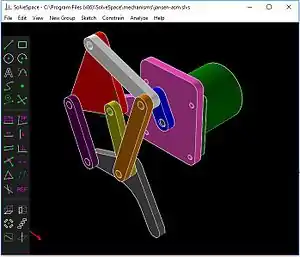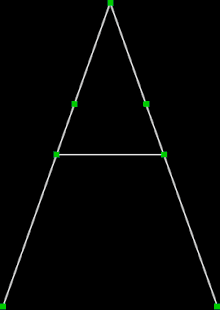SolveSpace
SolveSpace is a free and open-source 2D/3D constraint-based parametric computer-aided design (CAD) software that supports basic 2D and 3D modeling.
 A mechanical simulation in SolveSpace | |
| Developer(s) | Jonathan Westhues |
|---|---|
| Initial release | 2008 |
| Stable release | |
| Repository | |
| Written in | C++ |
| Operating system | Microsoft Windows, Linux, Mac OS |
| Platform | PC |
| Type | CAD |
| License | GPL-3.0-or-later |
| Website | solvespace |
It is a constraint-based parametric modeler with simple mechanical simulation capabilities. Version 2.1 and onward runs on Windows, Linux and macOS. The Linux version is shipped as a snap and native packages. It supports STEP and DFX for import and export. By default, SolveSpace utilizes its own CAD file format called .slvs for model storage. It is possible to export models as a whole or in part to various formats such as PDF, SVG, or Encapsulated PostScript (EPS).
It was initially created by Jonathan Westhues and as of 2022 is maintained by a community of volunteers.
History
Development of SolveSpace started in 2008. A previous software package called SketchFlat, also developed by Westhues, was replaced by SolveSpace.[2]
In an 2020 interview article with a major maintainer named "Whitequark", SolveSpace was described as being very conservative in terms of backward compatibility. The codebase at the time was about 30,000 lines of code and it took Whitequark almost 2 years to familiarize herself with it.[3][4] On September 22, 2020, Whitequark stepped down as a maintainer with the possibility of occasional contributions.[5]
Overview
SolveSpace is free and open source software distributed under the GPL-3.0-or-later license.[6]
Features
SolveSpace is shipped with the following basic features:[7][8]
- 2D Sketch Modeling
- SolveSpace supports parametric 2D drawing of lines, circles, arcs, Cubic bézier curves etc; datum points and lines are also supported for general, reference based modeling.[8]
- 3D Solid Modeling
- Drawing, extrusion, rotation and revolution along a helix are supported in both modes. In 3D it is possible to use basic Boolean operations (union, difference, intersection), though as of version 3.0, SolveSpace had limitations on the order of application of these operations.[8]

- Mechanical design and analysis
- By using the built-in constraint solver it is possible to visualize planar or spatial linkages with pin, ball, or slide joints, trace their movements, and export its data in
.cvsformat. - Assembly
- SolveSpace allows solids to be imported in a special mode that does not allow modeling. These imported solids can then be constrained to ensure that the designed model's dimensions meet necessary requirements.
- Plane and solid geometry
- Replace hand-solved trigonometry and spreadsheets with a live dimensioned drawing.
Supported file formats
Importing
SolveSpace can open and import its own textual *.slvs file formats for both editing and assembly. The DXF/DWG file format AutoCAD (version 2007) is supported for opening and editing.[8]
Exporting
SolveSpace v3.0 is able to export 2D sketches and surfaces into DXF/DWG (AutoCAD version 2007), PDF, SVG, EPS, and HPGL file formats. Wireframes can be exported as DXF and STEP files. Polygon meshes can be exported as STL and Wavefront OBJ; NURBS as STEP. SolveSpace is able to export models in STEP, STL, and G-code for reuse in third-party CAM software.[8]
Workflow
SolveSpace workflow starts either with opening an existing file or creating a new one and usually involves sketching. The basic shapes of a new physical part is sketched out and constrained to specific dimensions and locations. When the model is complete, it is either exported to one of the supported CAD formats or into a document for further processing.
Sketching
Modeling in SolveSpace is done by way of sketching in a workplane.[9] A workplane is plane with an origin for the new sketch where the SolveSpace draws entities. Users can make it active and draw basic primitives such as lines, circles, arcs, dots, and other points of references on the workplane, and constrain them to specific dimensions and relations.[9]
SolveSpace can split intersecting entities via a separate tool. Users can snap points to a grid.[9] There are no software limitations for the number of workplanes user can create.[9]
Constraints
Constraints include dimension limitation, angle, paralleling with another line, tangency, point, symmetry and alignment of a line with origin axes (to make them "vertical" or "horizontal").[9] The radius of a circle, for instance, can be constrained to a specific value, or can be influenced by some other entity dimension.
3D modeling
When sketching is complete, a 3D part can be extruded into a volumetric model for further modeling. An extruded model creates a group along a specified normal. Every group in SolveSpace encapsulates an action applied to the specified sketch created for every 3D operation, such as an extrusion, rotation, or translation. Created 3D models can also be further constrained with the basic tools mentioned above or combined with another one by Boolean operations.
It is also possible to draw a workplane on a specific "surface" of another 3D model; the surface is usually indicated by two line segments joined by a point.
Assembly
In order to verify a newly modeled concept in SolveSpace, users can "link" all the components and constrain them at specific positions to check whether the virtual end-product meets the original concept's design and constraints.[9]
Libraries
SolveSpace depends upon ANGLE, OpenGL Utility Library, zlib, libpng, libdxfrw, cairo, , mimalloc, libsigc++ and some other C++ libraries, as well as freetype2, harfbuzz, and Pango for text rendering. Linux specific libraries include gtk-3, Gio, and X11.
Limitations
As of v2.1., SolveSpace reference lists a disclaimer on limited support for NURB-surface Boolean operations which may occasionally fail.[9]
Criticism
A 2013 article and interview with the main developer published in Libre Graphics World has praised SolveSpace for its small executable file size, advanced constraints solver, and output formats.[10] However, it was also criticized for some drawbacks it had at the time, such as limited support for NURBS (i.e. boolean operations) and a lack of native Linux support, the latter of which has since been rectified.[10]
See also
References
- "Release 3.0". 18 April 2021. Retrieved 20 April 2021.
- "SketchFlat: 2d CAD, with Constraints".
- Asay, Matt (2020-08-07). "The secret to becoming an open source project lead". TechRepublic. Retrieved 2022-02-08.
- Asay, Matt (2020-05-18). "Why slowing new feature development can be the best way to maintain an open source project". TechRepublic. Retrieved 2022-02-08.
- "Stepping down as a maintainer · Issue #714 · solvespace/solvespace". GitHub. Retrieved 2022-02-08.
- "SolveSpace CAD Software | AnyTechTrial". www.anytechtrial.com. Retrieved 2022-02-08.
- "SolveSpace - parametric 3d CAD".
- "SolveSpace - Features". solvespace.github.io. Retrieved 2022-02-12.
- "SolveSpace - Reference". solvespace.com. Retrieved 2022-02-08.
- Prokoudine, Alexandre. "SolveSpace 2D/3D CAD software released under terms of GPL". Libre Graphics World, June 2013. Archived from the original on November 12, 2020. Retrieved 12 June 2016.